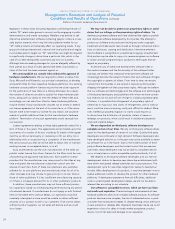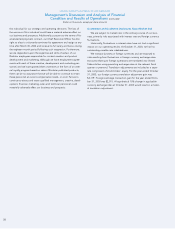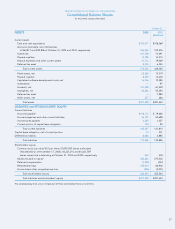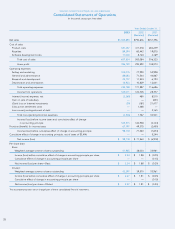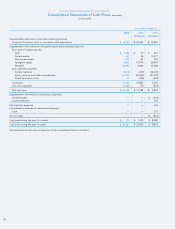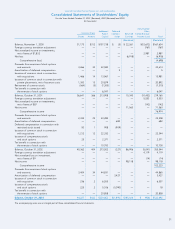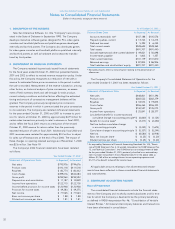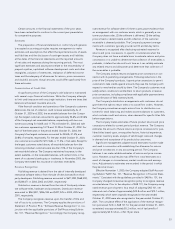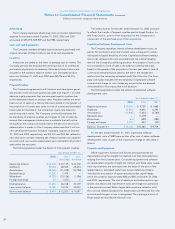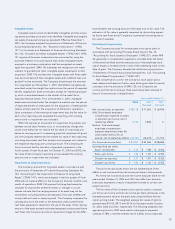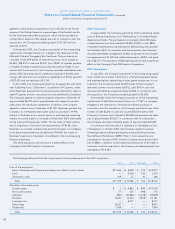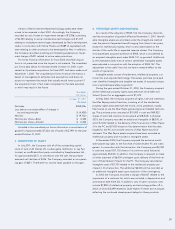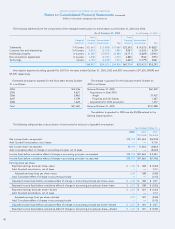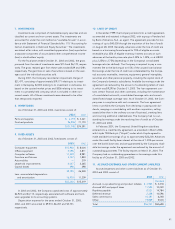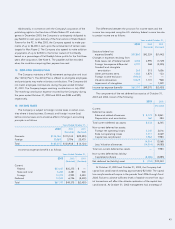2K Sports 2003 Annual Report Download - page 35
Download and view the complete annual report
Please find page 35 of the 2003 2K Sports annual report below. You can navigate through the pages in the report by either clicking on the pages listed below, or by using the keyword search tool below to find specific information within the annual report.
Certain amounts in the financial statements of the prior years
have been reclassified to conform to the current year presentation
for comparative purposes.
Estimates
The preparation of financial statements in conformity with general-
ly accepted accounting principles requires management to make
estimates and assumptions that affect the reported amounts of assets
and liabilities and the disclosure of contingent assets and liabilities
at the dates of the financial statements and the reported amounts
of net sales and expenses during the reporting periods. The most
significant estimates and assumptions relate to the recoverability of
prepaid royalties, capitalized software development costs and other
intangibles, valuation of inventories, realization of deferred income
taxes and the adequacy of allowances for returns, price concessions
and doubtful accounts. Actual amounts could differ significantly from
these estimates.
Concentration of Credit Risk
A significant portion of the Company’s cash balance is maintained
with several major financial institutions. While the Company attempts
to limit credit exposure with any single institution, there are times that
balances will exceed insurable amounts.
If the financial condition and operations of the Company’s customers
deteriorate, the risk of collection could increase substantially. As of
October 31, 2003 and 2002, the receivable balances from the Compa-
ny’s five largest customers amounted to approximately 54.6% and 43.6%
of the Company’s net receivable balance, respectively, with two cus-
tomers accounting for 16.6% and 11.7% at October 31, 2003 and with
two customers representing 14.1% and 10.3% at October 31, 2002. For
each of the three years in the period ended October 31, 2003, the
Company’s five largest customers accounted for 38.6%, 31.4%, and
20.8% of net sales, respectively. For the year ended October 31, 2003,
one customer accounted for $117,636, or 11.4%, of net sales. Except for
the largest customers noted above, all receivable balances from the
remaining individual customers were less than 10% of the Company’s
net receivable balance. The Company maintained insurance, to the
extent available, on the receivable balances, with certain limits, in the
event of a customer’s bankruptcy or insolvency. In November 2003, the
Company terminated this insurance on domestic receivables.
Revenue Recognition
Publishing revenue is derived from the sale of internally developed
interactive software titles or from the sale of titles licensed from third-
party developers. Publishing revenue amounted to $671,892, $568,492,
and $244,071 in 2003, 2002 and 2001, respectively.
Distribution revenue is derived from the sale of third-party interac-
tive software titles, hardware and accessories. Distribution revenue
amounted to $361,801, $226,184 and $207,325 in 2003, 2002 and
2001, respectively.
The Company recognizes revenue upon the transfer of title and
risk of loss to its customers. The Company applies the provisions of
Statement of Position 97-2, “Software Revenue Recognition” in con-
junction with the applicable provisions of Staff Accounting Bulletin
No. 101, “Revenue Recognition.” Accordingly, the Company recog-
nizes revenue for software when (1) there is persuasive evidence that
an arrangement with our customer exists, which is generally a cus-
tomer purchase order, (2) the software is delivered, (3) the selling
price is fixed or determinable and (4) collection of the customer
receivable is deemed probable. The Company’s payment arrange-
ments with customers typically provide net 30 and 60-day terms.
Revenue is recognized after deducting estimated reserves for
returns and price concessions. In specific circumstances when the
Company does not have a reliable basis to estimate returns and price
concessions or is unable to determine that collection of receivables is
probable, it defers the sale until such time as it can reliably estimate
any related returns and allowances and determine that collection of
the receivables is probable.
The Company accepts returns and grants price concessions in con-
nection with its publishing arrangements. Following reductions in the
price of the Company’s products, it grants price concessions to permit
customers to take credits against amounts they owe the Company with
respect to merchandise unsold by them. The Company’s customers must
satisfy certain conditions to entitle them to return products or receive
price concessions, including compliance with applicable payment terms
and confirmation of field inventory levels.
The Company’s distribution arrangements with customers do not
give them the right to return titles or to cancel firm orders. However,
the Company sometimes accepts returns from its distribution cus-
tomers for stock balancing and makes accommodations to customers,
which includes credit and returns, when demand for specific titles falls
below expectations.
The Company makes estimates of future product returns and price
concessions related to current period product revenue. The Company
estimates the amount of future returns and price concessions for pub-
lished titles based upon, among other factors, historical experience,
customer inventory levels, analysis of sell-through rates and changes
in demand and acceptance of its products by consumers.
Significant management judgments and estimates must be made
and used in connection with establishing the allowance for returns
and price concessions in any accounting period. The Company
believes it can make reliable estimates of returns and price conces-
sions. However, actual results may differ from initial estimates as a
result of changes in circumstances, market conditions and assump-
tions. Adjustments to estimates are recorded in the period in which
they become known.
Effective November 1, 2000, the Company adopted Staff Account-
ing Bulletin (“SAB”) No. 101, “Revenue Recognition in Financial State-
ments.” Consistent with the guidelines provided in SAB No. 101, the
Company changed its revenue recognition policy to recognize revenue
as noted above. Prior to the adoption of SAB 101, the Company recog-
nized revenue upon shipment. As a result of adopting SAB 101, net
sales and cost of sales of approximately $23.8 million and $15.1 million,
respectively, which were originally recognized in the year ended
October 31, 2000 were also recognized in the year ended October 31,
2001. The cumulative effect of the application of the revenue recogni-
tion policies set forth in SAB 101 for the year ended October 31, 2001,
as restated, was approximately $5.2 million, net of tax benefit of
approximately $3.5 million, or $0.15 per share.
33



